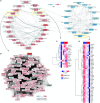Immune and Metabolic Signatures of COVID-19 Revealed by Transcriptomics Data Reuse
- PMID: 32670298
- PMCID: PMC7332781
- DOI: 10.3389/fimmu.2020.01636
Immune and Metabolic Signatures of COVID-19 Revealed by Transcriptomics Data Reuse
Abstract
The current pandemic of coronavirus disease 19 (COVID-19) has affected millions of individuals and caused thousands of deaths worldwide. The pathophysiology of the disease is complex and mostly unknown. Therefore, identifying the molecular mechanisms that promote progression of the disease is critical to overcome this pandemic. To address such issues, recent studies have reported transcriptomic profiles of cells, tissues and fluids from COVID-19 patients that mainly demonstrated activation of humoral immunity, dysregulated type I and III interferon expression, intense innate immune responses and inflammatory signaling. Here, we provide novel perspectives on the pathophysiology of COVID-19 using robust functional approaches to analyze public transcriptome datasets. In addition, we compared the transcriptional signature of COVID-19 patients with individuals infected with SARS-CoV-1 and Influenza A (IAV) viruses. We identified a core transcriptional signature induced by the respiratory viruses in peripheral leukocytes, whereas the absence of significant type I interferon/antiviral responses characterized SARS-CoV-2 infection. We also identified the higher expression of genes involved in metabolic pathways including heme biosynthesis, oxidative phosphorylation and tryptophan metabolism. A BTM-driven meta-analysis of bronchoalveolar lavage fluid (BALF) from COVID-19 patients showed significant enrichment for neutrophils and chemokines, which were also significant in data from lung tissue of one deceased COVID-19 patient. Importantly, our results indicate higher expression of genes related to oxidative phosphorylation both in peripheral mononuclear leukocytes and BALF, suggesting a critical role for mitochondrial activity during SARS-CoV-2 infection. Collectively, these data point for immunopathological features and targets that can be therapeutically exploited to control COVID-19.
Keywords: COVID-19; SARS-CoV; SARS-CoV-2; inflammation; influenza; metabolism; oxidative phosphorylation; transcriptomics.
Copyright © 2020 Gardinassi, Souza, Sales-Campos and Fonseca.
Figures



Similar articles
-
COVID-19 Hyperinflammation: What about Neutrophils?mSphere. 2020 Jun 24;5(3):e00367-20. doi: 10.1128/mSphere.00367-20. mSphere. 2020. PMID: 32581077 Free PMC article.
-
Type I and Type III Interferons Restrict SARS-CoV-2 Infection of Human Airway Epithelial Cultures.J Virol. 2020 Sep 15;94(19):e00985-20. doi: 10.1128/JVI.00985-20. Print 2020 Sep 15. J Virol. 2020. PMID: 32699094 Free PMC article.
-
SARS-CoV-2 infection of human ACE2-transgenic mice causes severe lung inflammation and impaired function.Nat Immunol. 2020 Nov;21(11):1327-1335. doi: 10.1038/s41590-020-0778-2. Epub 2020 Aug 24. Nat Immunol. 2020. PMID: 32839612 Free PMC article.
-
The cytokine storm in COVID-19: An overview of the involvement of the chemokine/chemokine-receptor system.Cytokine Growth Factor Rev. 2020 Jun;53:25-32. doi: 10.1016/j.cytogfr.2020.05.003. Epub 2020 May 11. Cytokine Growth Factor Rev. 2020. PMID: 32446778 Free PMC article. Review.
-
Innate Immune Signaling and Proteolytic Pathways in the Resolution or Exacerbation of SARS-CoV-2 in Covid-19: Key Therapeutic Targets?Front Immunol. 2020 May 28;11:1229. doi: 10.3389/fimmu.2020.01229. eCollection 2020. Front Immunol. 2020. PMID: 32574272 Free PMC article. Review.
Cited by
-
Effect of aberrant fructose metabolism following SARS-CoV-2 infection on colorectal cancer patients' poor prognosis.PLoS Comput Biol. 2024 Sep 27;20(9):e1012412. doi: 10.1371/journal.pcbi.1012412. eCollection 2024 Sep. PLoS Comput Biol. 2024. PMID: 39331675 Free PMC article.
-
Amino Acid Metabolism in Leukocytes Showing In Vitro IgG Memory from SARS-CoV2-Infected Patients.Diseases. 2024 Feb 23;12(3):43. doi: 10.3390/diseases12030043. Diseases. 2024. PMID: 38534967 Free PMC article. Review.
-
Lipid metabolism of plasma-derived small extracellular vesicles in COVID-19 convalescent patients.Sci Rep. 2023 Oct 3;13(1):16642. doi: 10.1038/s41598-023-43189-5. Sci Rep. 2023. PMID: 37789017 Free PMC article.
-
Host mitochondria: more than an organelle in SARS-CoV-2 infection.Front Cell Infect Microbiol. 2023 Aug 25;13:1228275. doi: 10.3389/fcimb.2023.1228275. eCollection 2023. Front Cell Infect Microbiol. 2023. PMID: 37692170 Free PMC article. Review.
-
Validation of reference gene stability for miRNA quantification by reverse transcription quantitative PCR in the peripheral blood of patients with COVID-19 critical illness.PLoS One. 2023 Aug 29;18(8):e0286871. doi: 10.1371/journal.pone.0286871. eCollection 2023. PLoS One. 2023. PMID: 37643172 Free PMC article.
References
-
- Gardinassi LG, Arévalo-Herrera M, Herrera S, Cordy RJ, Tran V, Smith MR, et al. . Integrative metabolomics and transcriptomics signatures of clinical tolerance to Plasmodium vivax reveal activation of innate cell immunity and T cell signaling. Redox Biol. (2018) 17:158–70. 10.1016/j.redox.2018.04.011 - DOI - PMC - PubMed
MeSH terms
Substances
LinkOut - more resources
Full Text Sources
Miscellaneous

